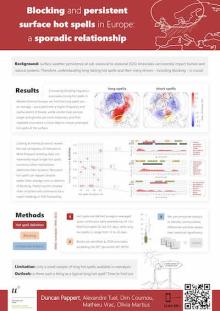The dynamics of persistent hotspells in European summers: an impacts perspective
Duncan
Pappert
Institute of Geography and Oeschger Centre for Climate Change Research, University of Bern, Bern, Switzerland
Poster
Persistent summer weather can result in extreme events with enormous socio-economic impacts; recent summers in Europe have notably demonstrated this. The dynamics that cause persistent surface weather, as well as potential changes under anthropogenic climate change, are the subject of active scientific debate. Summertime atmospheric dynamics have nevertheless received less attention and we are far from obtaining a comprehensive understanding of the mechanisms involved in the formation of persistent weather conditions in summer. This study investigates the drivers responsible for making some events more prone to being long-lasting than others. Gaining a comprehensive understanding of such processes poses challenges due to the complex interactions of variables and fluxes operating at various timescales – from individual weather events (daily to weekly), to the general circulation of the atmosphere and its modulation by specific changes in sea surface temperature or soil moisture interactions (monthly, seasonal to interannual). Furthermore, studies a recently understanding out that persistent (quasi-stationary or recurrent) circulation patterns do not necessarily translate to persistence at the surface – this discussion extends to open questions about e.g. the exact role of atmospheric blocking in sustaining persistent heat extremes at the surface.
Starting from an impact-based definition of persistent hot conditions, we look at the associated circulation patterns and surface conditions, characterise their persistence and try quantify their respective potential contribution. We use the ERA5 reanalysis dataset to take advantage of its high spatiotemporal resolution and relatively long temporal coverage from the 1950s up to today.
Deeper investigation into the dynamical processes controlling persistent surface conditions over Europe in summer is essential for improved predictability at the sub-seasonal to seasonal (S2S) timescale and highly relevant for risk preparedness. Results from the study will help to move the discussion on summer dynamics, weather persistence and climate impacts forward.
Starting from an impact-based definition of persistent hot conditions, we look at the associated circulation patterns and surface conditions, characterise their persistence and try quantify their respective potential contribution. We use the ERA5 reanalysis dataset to take advantage of its high spatiotemporal resolution and relatively long temporal coverage from the 1950s up to today.
Deeper investigation into the dynamical processes controlling persistent surface conditions over Europe in summer is essential for improved predictability at the sub-seasonal to seasonal (S2S) timescale and highly relevant for risk preparedness. Results from the study will help to move the discussion on summer dynamics, weather persistence and climate impacts forward.

Poster file
Pappert_Duncan_blocking_poster.pdf
(1.17 MB)
Meeting homepage
